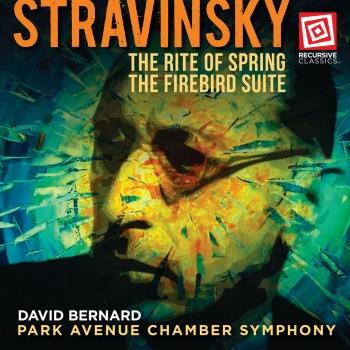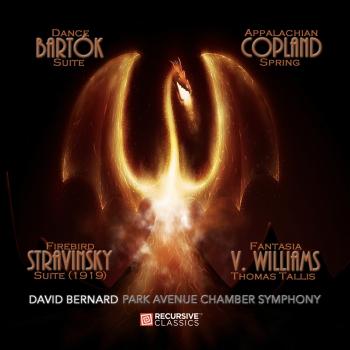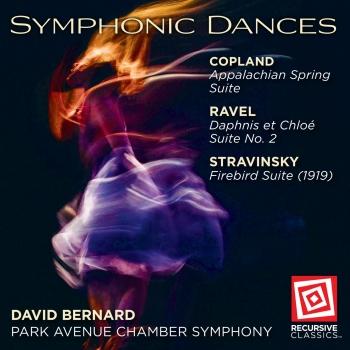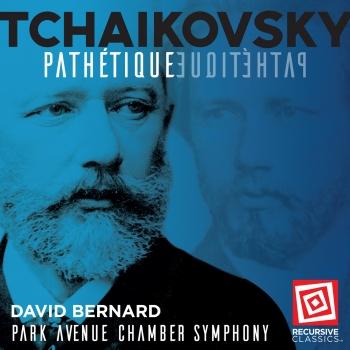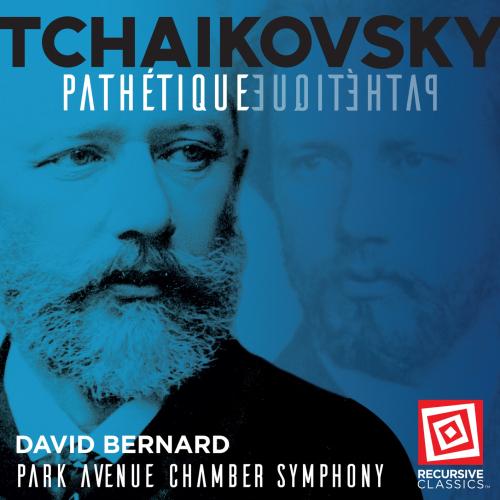
Tchaikovsky: Symphony No. 6 in B Minor, Op. 74, TH 30 "Pathétique" Park Avenue Chamber Symphony & David Bernard
Album info
Album-Release:
2018
HRA-Release:
09.03.2021
Label: Recursive Classics
Genre: Classical
Subgenre: Orchestral
Artist: Park Avenue Chamber Symphony & David Bernard
Composer: Piotr Ilyich Tchaikovsky (1840-1993)
Album including Album cover
- Pyotr Ilyich Tchaikovsky (1840 - 1893): Symphony No. 6 in B Minor, Op. 74, TH 30 "Pathétique":
- 1 Tchaikovsky: Symphony No. 6 in B Minor, Op. 74, TH 30 "Pathétique": I. Adagio - Allegro non troppo 18:09
- 2 Tchaikovsky: Symphony No. 6 in B Minor, Op. 74, TH 30 "Pathétique": II. Allegro con grazia 07:38
- 3 Tchaikovsky: Symphony No. 6 in B Minor, Op. 74, TH 30 "Pathétique": III. Allegro molto vivace 08:20
- 4 Tchaikovsky: Symphony No. 6 in B Minor, Op. 74, TH 30 "Pathétique": IV. Finale. Adagio lamentoso 11:06
Info for Tchaikovsky: Symphony No. 6 in B Minor, Op. 74, TH 30 "Pathétique"
Tchaikovsky toyed with the public on the meaning of his final symphony, proclaiming an underlying program existed, but refusing to disclose it. His death shortly after its premiere brought a perfect storm of mystery and intrigue, leaving an imaginative public to proclaim this work was his suicide note.
In this new Recursive Classics release, David Bernard brings a fresh look at Tchaikovsky s Pathétique . The circumstantial drama that surrounds the Pathétique can be an incentive for performers to see each and every phrase as an opportunity to express mournful longing a practice that isn t especially helpful to the work, says Bernard. And when considering the work as a whole, the suicide note theory that is used as the basis for this thinking is somewhat questionable. The Pathétique s immense scale and relentless passion demands a life force in the composer that simply could not exist inside a person resigned to take his own life.
Bernard sees the Pathétique as Tchaikovsky recalling his earlier works in a new-found artistic voice. You hear Tchaikovsky reimagining his life s work through a more mature and effective lens, says Bernard. The first movement s narrative shape is unmistakably linked to his Romeo and Juliet Fantasy Overture, requiring a balance between emotional depth and penetrating line in the well-known lyrical second theme, suddenly launching relentlessly driven episodes that bring us to a gut-wrenching largamente and a final retelling of the lyrical theme with an epilogue through which the energy of the movement is released. The second movement reimagines Tchaikovsky s ballet waltzes, requiring a flow that enables a light half note lifted pulse at the ends of each 5/4 measure, gliding the listener from beginning to end. The Third Movement s reconstitution of Tchaikovsky s symphonic finales requires an unceasing energy that drives relentlessly to an ending that is as inevitable as it is exciting. While the first three movements offer a look back, the Finale looks inward to the present, conveying Tchaikovsky s growing awareness of his fate portraying Tchaikovsky s emotional transformation through progressively more expansive pacing. It is here where the entire program of the Pathétique comes into focus gradually, note-by-note, until the work winds down to silence, with us and Tchaikovsky achieving closure in the silence that follows.
"...an impressively elegant, thoughtful, well balanced and sophisticated Tchaikovsky Pathétique...carefully sculpted phrasing in the finale's thematic statements, their pointed articulation throughout the second movement and the X ray clarity of the low strings underneath the bassoon solo in the first movement's opening Adagio...The second movement's outer sections take Tchaikovsky's con grazia directive to heart, with the melodies taking playful shape as they move over the bar lines. The finale's songful fluency and unanimity of phrasing communicate a dignified reserve...in the third movement, Bernard's excellent textural contouring gives bristling focus to the compound 12/8 and 4/4 metre, and the march theme's wonderful trombone and tuba parts emerge like newly scrubbed details in a restored painting...Bernard and his musicians frequently shed new and valuable light on a thrice-familiar standard, abetted by a recorded ambiance that evokes concert hall realism." (Gramophone)
"...a version for our times, no less affective but perhaps less fully drenched in emotive despair. I find it convincing....Snappy crispness and lush, sad fogs come through nicely. And some of the soggy bloat of the large orchestra in some of the less stellar performances is avoided completely." (Gapplegate Classical Modern Music Review)
"Bernard's reading is one more of beauty and elegance than purely of tragedy, pathos, or suffering....as thrilling as they come...the music appears neither tragic nor sorrowful, just longing, wistful, meditative...with feelings of contemplation and reflection...The ensemble's performance is commendably precise, the contrasts in softer and louder passages especially telling in their nuanced delivery." (Classical Candor)
Park Avenue Chamber Symphony
David Bernard, conductor
David Bernard
has gained recognition for his dramatic and incisive conducting in the United Stated and in over 20 countries on four continents. He serves as Music Director of the Park Avenue Chamber Symphony and the Massapequa Philharmonic. A multiple First Prize winner of the Orchestral Conducting Competition of The American Prize, Bernard was described in the judges’ remarks as, “a first-rate conductor…phenomenal performance…masterly in shaping, phrasing, technique and expressivity.” lucidculture praised Bernard’s recent Lincoln Center performance of Stravinsky’s “The Rite of Spring”: “Conducting from memory, David Bernard led a transcendent performance. Segues were seamless, contrasts were vivid and Stravinsky’s whirling exchanges of voices were expertly choreographed.” Bernard’s complete recorded Beethoven symphony cycle was praised by Fanfare magazine for its “intensity, spontaneity, propulsive rhythm, textural clarity, dynamic control, and well-judged phrasing” (Fanfare). His recent premiere recording of a new edition of Stravinsky’s The Rite of Spring was praised by Gramophone as “committed and forceful…(with) thrilling moments”.
Particularly active throughout the greater New York City area, David Bernard has appeared as a guest conductor with orchestras including the Brooklyn Symphony, the Greater Newburgh Symphony Orchestra, the Litha Symphony, Manhattan School of Music, the Massapequa Philharmonic, the New York Symphonic Arts Ensemble, the Putnam Symphony and the South Shore Symphony. Devoted to the music of our own time, he has presented world premières of scores by Bruce Adolphe, Chris Caswell, John Mackey, Ted Rosenthal and Jake Runestad, and distinguished concert collaborators have included Anna Lee, Jeffrey Biegel, Carter Brey, David Chan, Catherine Cho, Adrian Daurov, Pedro Díaz, Edith Dowd, Stanley Drucker, Bart Feller, Ryu Goto, Whoopi Goldberg, Sirena Huang, Judith Ingolfsson, Yevgeny Kutik, Anna Lee, Jessica Lee, Kristin Lee, Jon Manasse, Anthony McGill, Spencer Myer, Todd Phillips, Kristin Sampson and Cameron Schutza.
David Bernard is an acclaimed orchestra builder and is sought after for his artistic leadership and innovation in community engagement. Under his leadership as Music Director, both the Park Avenue Chamber Symphony and the Massapequa Philharmonic have thrived—with growing audiences, expanded ensembles and increased critical acclaim. Bernard’s approach to growing new audiences for classical music include engaging families in the community through schools, presenting multi-media concert presentations and developing a new concert format—“Classical Music from the InsideOut” where audiences sit inside the orchestra during concerts. David Bernard’s InsideOut concerts with the Park Avenue Chamber Symphony and the Massapequa Philharmonic have been acclaimed by WQXR, Newsday, ClassicalWorld and the Epoch Times, bringing an unsurpassed experience and level of engagement for the audiences of all ages.
This album contains no booklet.













